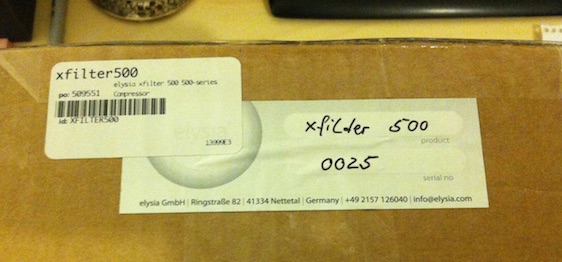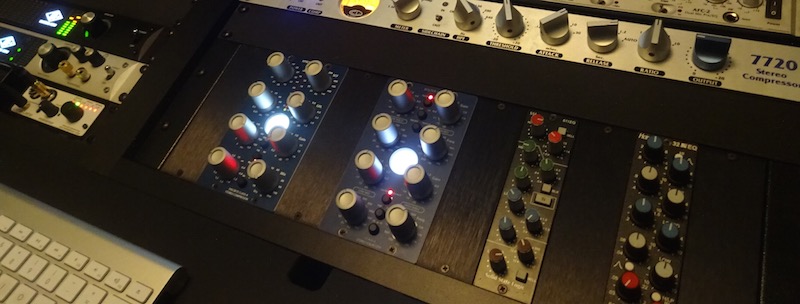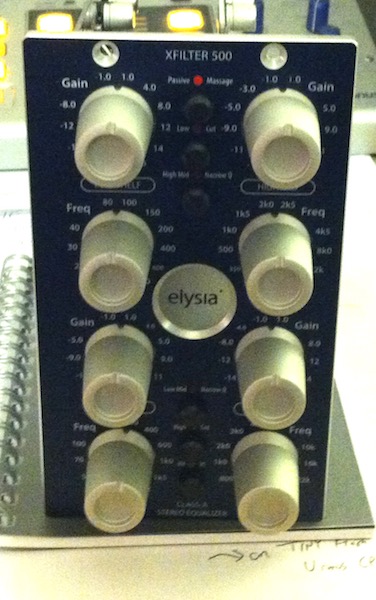The Elysia Xfilter 500 ($975) is currently my favorite analog mastering equalizer. Even after 2.5 years of owning one with almost daily use, it still puts an evil smile on my face every time I put it “in the chain”. Through the years, I have owned at least 4 other stereo equalizers, and have used many more, including such brands as API, Manley, BAE, Toft/Trident, Rupert Neve, SSL and Black Lion Audio; but my Xfilter 500 tops them all.
Purchased in June 2014, to act as a second “flavor” of analog mastering EQ, I was immediately seduced by the look, feel and especially the sound of the Xfilter. This little unit from Elysia just dominated my Black Lion Audio AM-CH1 in every single department. The clarity, ease of use and recall-ability wasn’t even comparable between the two. Quickly, the AM-CH1 was sold…
I’ll get the basics out of the way- the Elysia xfilter 500 is a 500-series, solid state, stereo equalizer. There is one set of knobs that controls both channels, made up of 4 frequency bands, plus a “passive massage” mode; “narrow Q” buttons for the middle two bands, and buttons to switch between shelving and filtering on both of the HF & LF bands. Nothing super fancy, but it is extremely clean and exactly what I need in my mastering chain these days. The price of $975 isn’t much for what you’re getting here, as I’ve paid more for way less…Another cool fact- I have serial #25!

…fucking awesome- straight up! Typically, I have the xfilter inserted after the analog compressor in my chain, but I have also used it in front of other compressors with great results. This is usually the last analog processor before A-D conversion, and it’s perfect for adding that little bit of creamy air, bass shelving and/or midrange adjustment to hit the ADC just right. I rarely use the “passive massage” mode, which darkens and warms the sound somewhat, but I could see it being utterly purrfect on room mics at mix down.
With settings flat, just inserting the unit into the path, I can usually hear a tiny bump in brightness or “clarity”, presumably because of the solid-state design and slightly lower headroom of 500-series gear. Testing the unit with sine waves of varying amplitude, I found this “brightness” to be a (very slight) increase in odd harmonics. By varying gain structure into the unit, this slight brightness can be exaggerated with hotter levels, or diminished by using lower levels. The more level in, the more odd harmonics generated. Just be sure to listen to it flat before making any adjustments, because more often than not, you’ll need less top EQ than you thought! That being said, this is NOT a thin or harsh sounding unit; it is warm and sweet if you want it to be, but mostly neutral in color.

I have yet to hear better HF “air” on ANY equalizer, and I’ve heard my share go great (and not so great) EQs. However, the xfilter is far from being a one-trick pony. Using the LF (in shelf mode), it’s possible to add in a touch of “sub” without muddying-up the overall sound, plus both the LMF and HMF bands are laser-accurate. The frequency range in each band is more than most would ever need. For the sometimes-typical mastering EQ adjustments (ex. LF shelf, slight LMF cut, air boost) it gets the job done perfectly. In fact, when a mix is already really good, I can get away with just a dB (or two) adjustment on this unit- no additional analog OR digital EQ needed! When a tighter Q is needed (usually for cuts in the lower midrange or sibilance area) the “Narrow Q” buttons are set up just right to grab problem frequencies, without disturbing the rest of the spectrum. I almost always use the LF and HF in shelving mode, but the filter modes sound good to me and I wouldn’t hesitate to use them for mastering, mixing or tracking scenarios.

Well, there are some teensy-teensy nitpicks I have. As many other reviewers have mentioned, the detents are set up in a way that can make recalling a bit tricky. Although the detents are very helpful and close-spaced in a usable way, they don’t always land on spots that have the value indicated. In use, and in sound, this is a non-issue because I am using my ears, not my eyes, when working. It just makes writing down settings tougher. I use a system of documenting the nearest indicated value (ex. +1dB), followed by how many “clicks” away, and in what direction (+ or -).
Not that it’s a bad thing, per se, but I should also mention (again) that even set “flat”, the xfilter 500 can add a bit of sheen when the incoming signal is above a certain level. For mastering duties I keep the input level at, or just under -15dB RMS to avoid over-coloring, and then just go up or down a few dB from there for desired effect. 9 times out of 10 this trait a “good thing” though- almost like an increase in definition, rather than just boosting treble response. Just the other day I mastered a jazz project that was very balanced, but needed just a pinch of clarity and turning the xfilter on was all the EQ I needed- cool!
In closing, the Elysia Xfilter 500 is beyond my expectations in almost every way. It is used affectionately and constantly.
I couldn’t score it any lower than a…
9.5/10 in both value and overall performance
PROS: great feature set, immaculate sound, value-priced, solid and reliable for daily mastering use
CONS: detents are a bit oddly “placed”, slightly colored (bright) sound when driven hard
Like this post and want to see more? fuzzywallz.com/posts/
© 2024 Fuzzywallz Recordings LLC